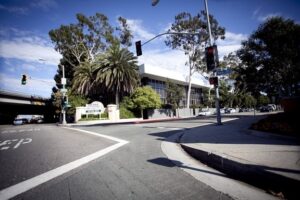CITY HALL — The City Council voted 6 to 0 Tuesday to study further a 260-unit apartment complex planned for the eastern end of Santa Monica despite the fact that the developer proposes to build it 19 feet from a freeway.
The developer will have to do additional environmental work to determine whether or not the small distance from the freeway will have a health impact on potential residents or employees at the development, and will also study separate plans with different levels of commercial and residential use, the council said.
Councilwoman Pam O'Connor was not present for the vote.
The development, put forward by Trammell Crow Co., would replace an old complex at 3402 Pico Blvd. that used to house the offices of the company that puts on the Grammys with a four-building mixed-use complex.

The project would include 2,999 square feet of ground floor commercial area and 505 parking spaces inside a two-level subterranean parking garage.
The developer removed 40 residential units and almost 2,000 square feet of commercial space in response to comments put forward by the Planning Commission at one of its early meetings on the development, and has a mix of units to accommodate single people and small families.
Over 40 community members lined up to speak against the project, citing concerns about pollution and the traffic impact of the potential development.
Health advocates say that the project is poorly placed, and that almost anyone with lungs will feel the impact of living so close to the bustling Interstate 10.
The California Air Resources Board recommends that people live no closer than 500 feet from a freeway.
Children who live near freeways suffer from asthma and other respiratory problems, and expecting mothers tend to have premature babies or babies with low birthrate when they're near freeways, said Andrea Hricko, a professor of preventative medicine at USC and a Sunset Park resident.
Hricko is working with a team of scientists who found a relationship between air pollution and autism if children are exposed early in life.
"I would urge the city to deny any proposal for anything in the city that has this kind of proximity to a freeway," Hricko said. "I am quite surprised that this enlightened City Council in an environmentally-conscious city hasn't grappled with this issue in the past."
Traffic also raised a red flag for many residents.
Two more developments with almost 900 additional housing units between them are planned within 2 miles east down Pico Boulevard from the proposed building, and residents fear that an already-crowded road will become impassable.
"The cumulative effects of all of them will be much greater than any of the pieces," said Nancy Morse, a Santa Monica resident.
Gregory Ames, who spoke for the developer, stressed that council's "yes" vote would not approve the project, simply allow the developer to go forward with environmental studies to determine how many extra cars the project would produce.
"We're only technically seeking approval to begin the environmental review process to actually study the (impacts) of the proposal," Ames said.
He also pointed out that the developer had a right to build 45,000 square feet of office space and 67 units on the property as is, with no community input or benefits.
That changed the question from one of traffic prevention or reduction to the lesser of two evils: The housing complex reached through a development agreement or the office complex, which could be built without special permissions and community benefits.
"Traffic will get worse whether we approve the project or not," said Mayor Pro Tem Gleam Davis.
The City Council asked that the developer look at the traffic impacts of the by-right development, and for an additional facet focused on health impacts of pollution.
Although the studies would show whether or not the project would create an untenable traffic situation at the busy area near the freeway on and offramps, it would not answer the health concerns regarding pollution because the reports examine the impact of a project on the environment, not vice versa, said David Martin, Planning Director at City Hall.
"I have serious concerns about the air quality and health of the residents who would live in the project," said Councilmember Terry O'Day.
ashley@www.smdp.com









